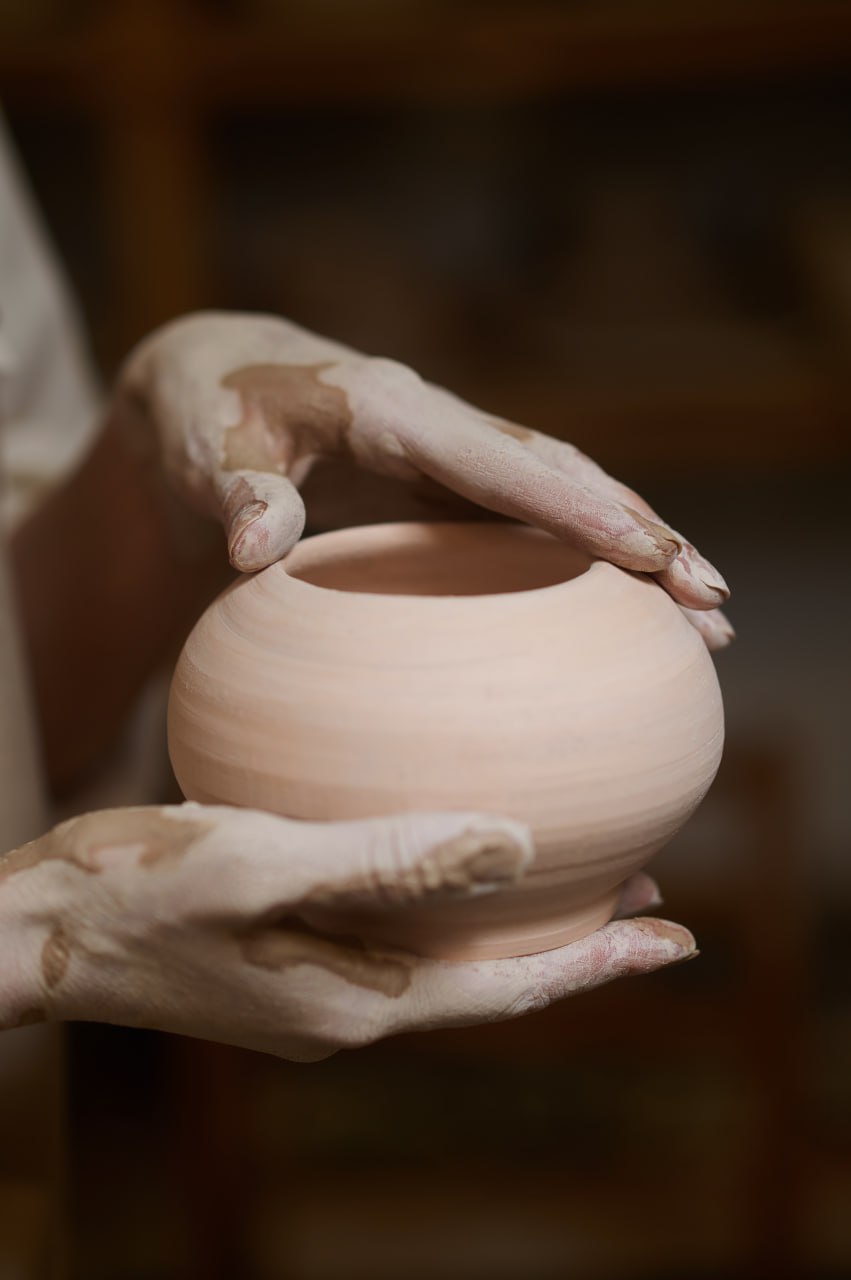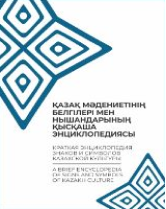
Pottery and ceramics
For cultural historians the traditions of ceramic art became a kind of “mirror”, reflecting the key events of the Great Steppe, and the original centres of pottery and ceramic art were the regions of South Kazakhstan.
By examining the composition of a wide variety of clay shards, archaeologists reconstruct not only the technological features of production, but also the composition of the clay mass. In some regions it may contain shells (the Aral Sea region), while in others it may contain sand, wool or chamotte.
Pottery in Kazakhstan, developing actively perceived all innovations of the craft, and the best samples of ceramics came to the country thanks to the Great Silk Road. Experts speak about Iranian, Chinese and even Japanese influence on local ceramics. Thus, craftsmen sought to create not only practical but also attractive products, painting them in different colours and coating them with glazes.
This craft was most widespread in the southern and southwestern regions during the Turkic era. The influence of irrigated pottery from Central Asia is strong in these regions. Historic chronicles describe blossoming ancient Kazakh towns, and their archaeological research has revealed entire neighbourhoods of potters and craft workshops.
Gradually, over time, the Otrar, Taraz and Turkestan medieval schools of ceramics emerged, distinguished by their distinctive style, known far beyond the borders of the Steppe. For example, masters of the Taraz school often used the graffito method in glazed ceramics, which was widespread in the early Islamic art of the Middle East.
During the archaeological research of Otrar oasis a huge amount of all kinds of ceramic dishes – vessels, jugs, dishes, bowls, etc., covered with fine green and blue glaze, which are ornamented zoomorphic, geometric and floral patterns was discovered. Specialists are still unable to unravel the secrets of making some types of glaze, such as the blue one.
In the 15th century, the “Timurid style” became predominant. It is first and foremost distinguished by its special colouring, which was given by shades of cobalt on white engobe, and a blue and turquoise glaze was applied on top. Later, in the 16th century, ceramics were decorated with three colours, but the tradition of decorating patterns with cobalt on white engobe was still strong. The ornamentation was applied not only to the visible surface of the items, but also to the bottom of the vessels. Plant motifs became predominant, especially motifs of grapevines and shoots, flower bushes, twigs with leaves and flowers, etc. In turn, geometric motifs are not as popular here as before.
In the developed Middle Ages one of the brightest and most original schools of Kazakh ceramics was formed – Turkestan ceramics. The city of Yasy (Turkestan) became a large centre of pottery production. Masters manufactured glazed and unglazed pottery in rather large volumes here. At excavation of the city whole quarters of potters with kilns of big production capacity were also found. Turkestan glazed ceramics in its mass is characterized by blue-green colouring, there are also examples of unique and spectacular yellow-toned ceramics.
By the seventeenth century, potters began to abandon cobalt paintings, to be replaced by dark brown manganese on a white glaze. Gradually green painting on yellow glaze became predominant. This process is most probably due to the weakening of trade along the Great Silk Road route and the high cost of cobalt.
With all the canonicity of compositional techniques developed in the common Central Asian style – zone and concentric principle of ornamental decoration, Turkestan masters varied in the way they decorated the surface of the product. For instance, while in one case the composition may cover the entire surface, in another case it covers only certain areas – the sides. In general, the composition can be placed centrally, divide the surface into parts, etc.
It goes without saying that the decoration depends on the shape and purpose of the product and is conditioned by the potter’s skill and creative imagination. As a rule, ornamentation is applied to a large surface of the product, but does not absorb the entire form. Magical and ritualistic meanings of ornamental patterns are of no small importance in the ornamentation of pottery. The walls of antique items can even be marked with the authorship of a particular master (name stamps).
The complication of political, social and economic situation in Kazakhstan in the 18th century led to extinction of pottery traditions in its primordial centres. A transfer of cultural routes from south to north could be observed, which eventually led to the deterioration of the quality of firing and simplification of painting. Plasticity, fine taste and special colouring of local ceramics began to disappear. Another reason for the regression of local production was the massive importation of Russian ceramics and, in general, the local market was actively saturated with imported goods. This eventually led to the displacement of local craftsmen from the market. Unfortunately, local producers could not cope with this competition.
At the same time, archaeological researches of the cities of the Turkestan oasis reveal professionalism of pottery in the Middle Ages. Local pottery covered the needs of the domestic market and was partly exported. During this period, the tradition of making ceramic crockery for special occasions in the family and the community, by ordering it from a skilled craftsman, was still alive. This is exemplified by the name of one type of crockery, that lagan, which was made exclusively to order for a solemn occasion, such as the birth of a child.
In addition to irrigation articles, craftsmen made sanitary articles – tashnau, elements of traditional hydraulic engineering system – karizes, and, at an earlier date, small ritual articles – figures of deities, animals, etc.
Skilled potters, like other crafts, have traditionally been highly respected and revered by the population. Gradually, by the twentieth century, the original tradition of pottery had all but disappeared, and many of the techniques are now considered to have been lost.
With the development of professional art education a new kind of art began to be created: “national in form” but socialist in content. This had a negative impact on the primordial tradition which practically disappeared by the end of the 19th century and the beginning of the 20th century. This had a negative effect on the original tradition which practically disappeared at the end of the 19th and beginning of the 20th centuries.
At present, there is an aspiration of masters to revive the traditional pottery craft. Renowned representatives of the “national” school of ceramics Marat Sarsebayev, Aliakar Musayev, Abay Ryspaev and Olzhabay Sholakhov are reviving it with inspiration. Each of these potters has pupils with whom they generously share their experience.
The reddish-yellow glazed jugs, pots, candlesticks and small plastic folklore images made by the master potters are marked by fine taste and new rhythmic and tectonic variants of traditional shapes and decorations. However, many pottery-making techniques have undergone considerable transformation.
The activities of the famous Shymkent master Kendybay Karabdolov occupies a special place in the processes of revival of the ancient craft of potters of the southern regions. Many years ago, within the framework of the State Programme “Cultural Heritage”, the master created the “Ethnomuseum-Kyluyet”, which is located underground at a depth of seven metres and consists of an underground mosque, a pottery workshop, a permanent exhibition of ceramics and a room for ethnographic concerts, using traditional Kazakh musical instruments, including pottery.
К. Kabdolov actively participates in archeological expeditions in the excavations of the site of Otrar, where he studies ancient specimens and strives to recreate authentic forms. The master sees his mission not only in the revival of traditional ceramics, but also in passing on his knowledge and experience to rising youth.
Today, his museum is a place of active and rich cultural life, visited by schoolchildren, students, scientists and simply lovers of antiquity, as well as tourists. The master is actively assisted by his son, Yerbolat Kendybayuly, a novice, but already taking confident steps in pottery.
A unique master from Turkestan, Abay Ryspayev, stands out among the brightest bearers of traditional pottery art. He is known for creating pottery using traditional technology and ancient patterns. The master uses only local clay, which is considered the best and most plastic. The master collects it in early spring at the bottom of the river Arys, and afterwards, the clay is processed according to an ancient technology for a long time. Abai Ryspaev’s products have been awarded the UNESCO Seal of Excellence for their authenticity and high standard of workmanship.
The range of activities of potters, apart from those mentioned above, also includes making traditional musical instruments of clay: sazsyrnai, üskirik and tastauyq. These are wind instruments (a type of pipe). Sazsyrnay has an ovoid shape and is 12-15 cm long and 9-10 cm in diameter. The instrument has six holes of different sizes, five on one side and one on the other. There is another hole at the end where the musician blows. For all its simplicity, the instrument can reproduce the blowing of a light steppe breeze, the clatter of horses’ hooves, the splash of water and the soft rustling of grass. Specialists believe that the saksirnay has a luminous timbre and a delicate and unusual sound.
Üskirik and tastauyq were also moulded from clay. They are known by specialists as related sazsyrnai and imitation instruments, which can imitate bird voices, animal cries and also reproduce natural phenomena such as howling of blizzards, snowstorms and wind.
After long neglect, the sazsirnai is undergoing a certain revival, with more and more young performers striving to master it. True, there are not many masters who make them. Among them: Zhailau Talasov (Sagiz station), Kendybay Karabdalov, Gaziz Zhumabekov and others.
One of the young masters and musicians actively engaged in popularising and promoting the traditional art of making and playing clay musical instruments is the Zhezkazgan master Azamat Bakiya. His private collection includes more than 1,500 ancient examples of musical instruments.
At present in Kazakhstan there is professional training in the art of ceramics at several higher educational institutions and colleges. Many artists and craftsmen strive for a synthesis of the old and the new, drawing on the diverse artistic experience of other cultures. Today, pottery as such is becoming not only an excellent way of embracing beauty, but also an effective method of art therapy. However, this is a very different perspective.
Our focus is on traditional pottery of South Kazakhstan, which may soon disappear into oblivion and remain only on the pages of publications. Therefore, the Kazakh traditional pottery is qualified as an element of ICH that requires urgent protection.



